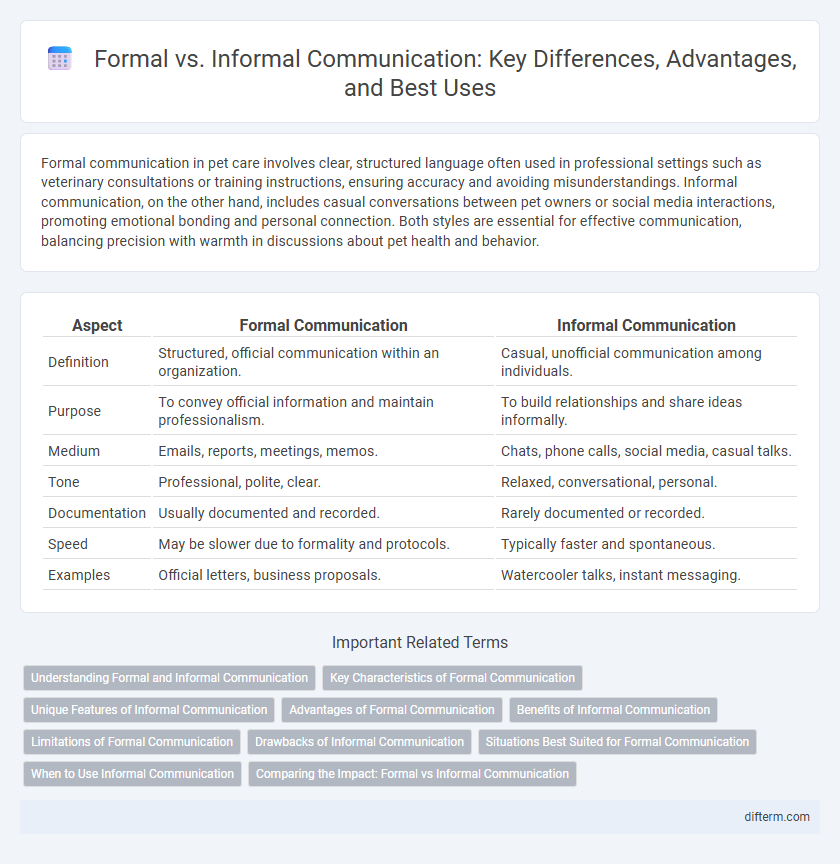Formal communication in pet care involves clear, structured language often used in professional settings such as veterinary consultations or training instructions, ensuring accuracy and avoiding misunderstandings. Informal communication, on the other hand, includes casual conversations between pet owners or social media interactions, promoting emotional bonding and personal connection. Both styles are essential for effective communication, balancing precision with warmth in discussions about pet health and behavior.
Table of Comparison
| Aspect | Formal Communication | Informal Communication |
|---|---|---|
| Definition | Structured, official communication within an organization. | Casual, unofficial communication among individuals. |
| Purpose | To convey official information and maintain professionalism. | To build relationships and share ideas informally. |
| Medium | Emails, reports, meetings, memos. | Chats, phone calls, social media, casual talks. |
| Tone | Professional, polite, clear. | Relaxed, conversational, personal. |
| Documentation | Usually documented and recorded. | Rarely documented or recorded. |
| Speed | May be slower due to formality and protocols. | Typically faster and spontaneous. |
| Examples | Official letters, business proposals. | Watercooler talks, instant messaging. |
Understanding Formal and Informal Communication
Formal communication follows structured channels and official protocols, often documented and used in professional settings to ensure clarity and accountability. Informal communication is more casual and spontaneous, occurring through personal interactions without strict rules, fostering quicker and more flexible exchanges of information. Understanding the differences helps organizations balance efficiency and relationship-building to optimize overall communication effectiveness.
Key Characteristics of Formal Communication
Formal communication is structured, follows predefined channels, and often documented for accountability and clarity within organizations. It relies on official language, hierarchical flow, and standardized formats such as memos, reports, and official meetings. This type of communication ensures consistency, reduces misunderstandings, and supports organizational policies and procedures.
Unique Features of Informal Communication
Informal communication thrives on spontaneity, using casual language and non-verbal cues that foster quick exchanges and personal connections within organizations. It often bypasses hierarchical structures, enabling employees to share ideas and feedback more freely and creatively. This communication style enhances social bonding, builds trust, and can accelerate problem-solving by facilitating open, two-way dialogue.
Advantages of Formal Communication
Formal communication ensures clarity and consistency in message delivery, reducing misunderstandings across organizational levels. It establishes a documented trail that aids in accountability and legal compliance. Structured channels also enhance professionalism and facilitate effective information flow in complex environments.
Benefits of Informal Communication
Informal communication enhances workplace relationships by fostering open dialogue and quicker information exchange, leading to increased collaboration and innovation. It breaks down hierarchical barriers, promoting a more inclusive and approachable environment where employees feel comfortable sharing ideas. This type of communication often results in faster decision-making and problem-solving, boosting overall organizational efficiency.
Limitations of Formal Communication
Formal communication often faces limitations such as rigidity in structure, which can slow down the exchange of information and hinder spontaneous feedback. The hierarchical nature restricts open dialogue, leading to potential misunderstandings or delays in problem-solving. Moreover, formal channels may exclude important informal cues like tone and body language, reducing overall communication effectiveness.
Drawbacks of Informal Communication
Informal communication often leads to misinformation due to lack of structure and accountability, causing confusion and errors in the workplace. It can undermine authority and disrupt organizational hierarchy, reducing efficiency and clarity in decision-making processes. Furthermore, informal networks may exclude certain employees, fostering misunderstandings and creating barriers to effective teamwork and collaboration.
Situations Best Suited for Formal Communication
Formal communication is best suited for situations requiring clear documentation and accountability, such as official meetings, corporate announcements, and legal correspondence. It ensures professionalism and consistency when conveying policies, procedures, and performance evaluations within an organization. This structured communication style is essential for maintaining hierarchical clarity and preventing misunderstandings in complex or sensitive contexts.
When to Use Informal Communication
Informal communication is best suited for quick, day-to-day interactions within teams where a relaxed tone fosters openness and creativity. It thrives in environments requiring immediate feedback, such as brainstorming sessions or casual check-ins, enhancing collaboration and relationship-building. Informal channels like instant messaging or face-to-face chats efficiently address routine updates without the constraints of formal protocols.
Comparing the Impact: Formal vs Informal Communication
Formal communication establishes clear hierarchies and accountability, ensuring that official messages are accurately conveyed and legally documented, which enhances organizational consistency and professionalism. Informal communication fosters quicker information exchange and builds stronger interpersonal relationships, promoting collaboration and creativity but sometimes leading to misunderstandings or rumor propagation. The impact of formal versus informal communication depends on the context, with formal channels supporting structured decision-making and informal channels driving innovation and employee engagement.
Formal vs Informal Communication Infographic

 difterm.com
difterm.com